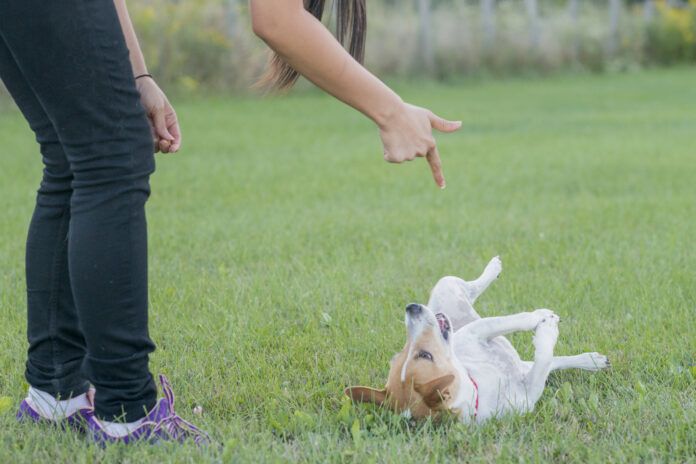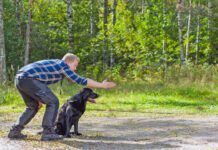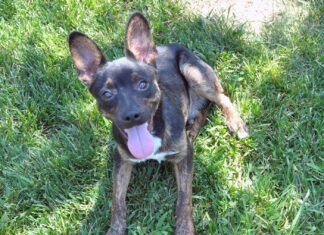Tricks are great crowd pleasers, and teaching your dog a trick is a fun way to bond. If “play dead” is on your tricks wish list, here’s what you need to know to achieve a star-worthy performance.
Getting Started
This trick is easiest to teach using a food lure. Use treats your dog is excited about. Small pieces of a soft treat work best.
Using a food lure requires your dog to follow a treat in your hand. Think of your treat as a magnet and your dog’s nose as the refrigerator. As you move the treat, keep the magnet on the fridge! A common mistake is to move the food too fast, breaking the connection between the magnet and the fridge and losing the dog’s focus in the process.
If training with a food lure is new for your or your dog, work on your treat-magnet/nose-fridge connection, and practice guiding your dog using only the lure. Remember: If you break the magnetic connection, you’re moving the food too fast.
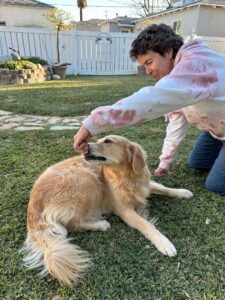
Step One: Rest on a Hip
Begin with your dog lying down. If her weight is balanced over both rear feet, we want to lure her onto her side so that her weight is on one hip.
With your treat magnet on her nose, slowly turn her head toward her hip. If turning her head toward her right hip, she should shift her weight onto her left hip. If turning her head toward her left hip, the weight shift will be onto her right hip. If your dog understands a marker (like “Yes!” or a clicker), mark the moment the weight shift happens and deliver the treat. If you don’t use a marker, just deliver the treat.
Take your time and be prepared to accept baby steps along the way toward getting the full weight transfer onto the hip. Some dogs are perfectly comfortable following the food and flopping on their hip, and some aren’t. If your dog seems confused or uncomfortable, reward the smallest variation of the desired behavior and ask for more as your dog becomes more comfortable.
Practice this step until you can lure you dog onto her hip in one fluid motion.
Step Two: Melt Onto Her Side
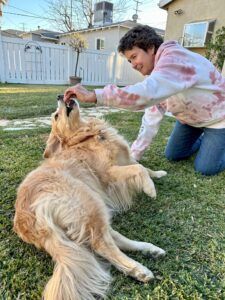
Keep the treat magnet on your dog’s nose and turn her head toward the non- weight-baring hip. Once her head is turned, slowly move your treat magnet in diagonal arc over her body. Following the food will start to ease her onto her side, with her head turned so that she’s looking back over his shoulder. From there, use your treat magnet to straighten her head and guide her body and head the rest of the way to the floor.
Some dogs find this more relaxing if it’s paired with a little gentle massage and calm reassurance. Don’t confuse gentle massage with forcing your dog into position. Lying flat is a vulnerable position for dogs. Don’t force it. Reward smaller versions along the way as necessary. For example, if your dog seems unsure, reward the first inch of a melt toward her side. When that looks easy, reward two inches, and so on.
If your dog struggles with this step and you find yourself feeling frustrated, take a break.
Practice this step until you can lure your dog fully onto her side in one fluid motion. Some dogs will learn this in one session. For others, it might take weeks. Meet your dog where she’s at and enjoy the journey!
Step Three: Maintaining the “Dead” Position
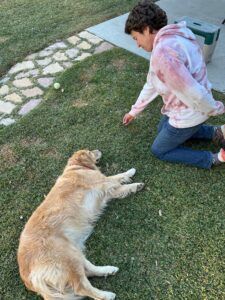
Load your hand with several treats. Lure your dog into the “dead” position. Let her nibble a treat or two from your hand, positioning your delivery so her head stays on the ground. Next, quickly slide your hand out and back along the floor and away from her face. Deliver another treat. With this step, the dog learns holding position when the food moves away makes the food return. How far, and how fast, you slide your hand will depend on your dog. For some dogs, this step will involve moving your hand only a couple of inches before very quickly returning to feed. As your dog catches on, move a little slower and farther away before returning to deliver a treat.
Practice this step until you can lure your dog fully onto her side in one fluid motion and she shows no sign of wanting to raise her head or get up as you move the food away from her face.
Step Four: Change Your Orientation and Practice in New Locations
Most people find it easiest to teach the first few steps while kneeling on the ground next to the dog. If that’s how you’ve been practicing, repeat the first three steps while you assume a different position. If you’ve been kneeling, and you can safely do so, try standing and bending over. Your posture change presents a new picture to your dog. If all is going well, make a point to practice in new locations.
Step Five: Fade the Food Lure
When you can easily lure your dog into the full “dead” position, play with transitioning from luring your dog with food (treat magnet on his nose) to guiding/luring your dog with a similar hand signal. Warm up with a repetition or two with food in your hand, then immediately perform a third repetition with the food hidden in the opposite hand, and reward from the opposite hand after your dog performs the behavior.


